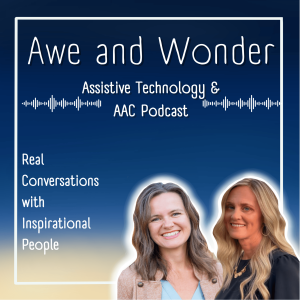Awe and Wonder Podcast: AAC & AT
Are you losing the human connection in the midst of data collection? Join Brenda and Sarah as they talk with inspirational people who create awe and wonder in unique ways. “Wonder inspires the wish to understand; awe inspires the wish to let shine, to acknowledge and to unite.” Ulrich Weger & Johannes Wagemann (sourced from Atlas of the Heart by Brene Brown) Participants will hear first hand accounts from people supporting students with complex needs. Assistive Technology, Augmentative Alternative Communication (AAC) and IEP goals are discussed, but human connection is highlighted throughout this engaging series.
Episodes

Wednesday Jul 02, 2025
Wednesday Jul 02, 2025
Tune in to a conversation with Erin, an expert in literacy and language development and a strong advocate for inclusive schools and communities. As a mother of a now teenager with autism and Angelman syndrome, Erin brings firsthand experience to her work at AssistiveWare. We discuss her journey through early intervention and the special education system, and the AT supports that proved essential for her daughter.
Resources:
Proloquo Thinking Space: https://www.assistiveware.com/support/proloquo/basics/proloquo-thinking-space
Angelman Syndrome: https://angelman.org/about-angelman-syndrome/
CVI: https://www.perkins.org/what-is-cvi/

Wednesday Jun 25, 2025
Wednesday Jun 25, 2025
Explore the impactful work of Bridget, an SLP at the University of Washington's Experimental Education Unit (EEU), an inclusive early childhood center. Learn how their transdisciplinary approach supports children (birth-kindergarten) with diverse communication needs through collaborative assessment, therapy, and teacher consultation. Bridget shares insights into fostering communication development and the power of teamwork in helping young learners thrive.
Resources:
UW Experimental Education Unit: https://haringcenter.org/eeu/
Haring Center for Inclusive Education: https://haringcenter.org/
Will AAC stop a person from learning to speak? https://www.assistiveware.com/learn-aac/roadblock-aac-will-stop-a-person-from-learning-to-speak
Printable AAC Core Boards: https://saltillo.com/chatcorner/content/29
Carrie Ebert, SLP https://www.instagram.com/cari.ebert.seminars/?hl=en
Playspark https://www.instagram.com/play_spark/

Wednesday Jun 18, 2025
Wednesday Jun 18, 2025
From stay-at-home mom to special education expert, hear how one mother's journey with her daughter, who has CHARGE syndrome, sparked a 21-year career. We delve into her experience as a Speech Therapy Assistant, her Masters in Special Education (Visually Impaired), and her work with children 0-3 and preschool at the Arizona State School for the Deaf and Blind.
Resources:
CHARGE Syndrome: https://www.chargesyndrome.org/overview/
State Deafblind Projects: https://www.nationaldb.org/state-deaf-blind-projects/
Remove.bg image background removal: https://www.remove.bg/
Oregon Project for Preschool Children Who Are Blind or Visually Impaired: https://www.pathstoliteracy.org/the-oregon-project-for-preschool-children-who-are-blind-or-visually-impaired/

Wednesday Jun 11, 2025
Wednesday Jun 11, 2025
Tune in for a conversation with Cass, a passionate advocate for equity and early access to robust high-tech AAC. As an autistic and ADHD mom of autistic children, she champions neuroaffirming approaches. We explore her personal experiences with AT in early intervention and her dedication to empowering families with the tools they need to thrive.

Wednesday Jun 04, 2025
Wednesday Jun 04, 2025
Ryan joins us to share her journey in early intervention and inclusive education. With a wealth of experience from preschool classrooms to Washington's Office of Superintendent of Public Instruction (OSPI), she's dedicated to ensuring all children thrive. Learn about her impactful work with the Preschool Inclusion Champions Network and her insights on the power of collaboration and assistive technology.

Wednesday May 28, 2025
Wednesday May 28, 2025
As a speech-language pathologist with 20 years of experience, specializing in early intervention, and a device representative for PRC-Saltillo, Shari brings a unique perspective. Hear her personal story of navigating her own children's communication journeys – the struggle of getting a device for her 8-year-old, and her youngest daughter who began using AAC at just 13 months. Discover how her professional expertise and lived experience intersect, offering invaluable insights for parents and professionals alike.

Thursday May 08, 2025
Thursday May 08, 2025
Join us as Rebecca shares her journey after her daughter Maeve's diagnosis of Joubert syndrome at just four months old. Discover how occupational therapist Mimi and cTVI Jillian stepped in, working alongside Rebecca to find and implement crucial assistive technology, opening up a world of communication and access for Maeve.

Monday Mar 03, 2025
Monday Mar 03, 2025
Tara and Shelly, a parent and educator team, founded Roots2Wings Family Group to support families of children with disabilities across Washington state. Their organization bridges a crucial gap by offering online training sessions and coordinating in-person events where parents can connect with multiple agencies under one roof to access essential resources and information.
Acronyms used: ABA: Applied Behavior Analysis DDA: Developmental Disabilities Administration
Resources:
Roots2Wings website: https://sites.google.com/view/roots2wings/home
Academy for Precision Learning: https://www.aplschool.org/
WA State Transition Services ages 16-21: https://ospi.k12.wa.us/student-success/special-education/family-engagement-and-guidance/transition-services-ages-16-21

Tuesday Feb 25, 2025
Tuesday Feb 25, 2025
Fran McCarthy has dedicated her career to championing students' needs in education. Her recent role as Executive Director of Student Support Services at Northwest Washington Educational Service District reflects her commitment to student advocacy. She is particularly passionate about fostering inclusive educational environments, implementing Universal Design for Learning principles, and developing project-based learning opportunities for students with disabilities and those principles are highlighted throughout this episode.
Resources:
TIES Center 5-15-45 Tool: https://tiescenter.org/resource/dl24-the-5-15-45-tool-grab-a-partner-and-lets-collaborate
Assistive Technology in the IEP: Writing Strength-Based IEPs
Washington State Educational Service Districts: https://ospi.k12.wa.us/about-ospi/about-school-districts/educational-service-districts-esd
Washington AIMS project (MTSS) https://goodladinstitute.org/aims/

Tuesday Feb 18, 2025
Tuesday Feb 18, 2025
Don Johnston, who founded and leads Building Wings as CEO, developed his company to create educational technology and curriculum specifically designed for students with disabilities. Drawing from his personal journey with dyslexia, including his own delayed path to reading proficiency, Don openly discusses how he overcame learning challenges through key support systems. His experiences inform his passionate advocacy for maintaining high expectations for all students, as he credits this approach as crucial for academic achievement.
Resources:
Building Wings: https://www.buildingwings.com/
Monarch Reader: https://www.buildingwings.com/monarch-reader-books-for-beginning-readers-of-all-ages/
News Currents: https://www.buildingwings.com/news-currents/
Dynamic Learning Maps (DLM): https://dynamiclearningmaps.org/
Tiered Vocabulary: https://cpet.tc.columbia.edu/news-press/tiered-vocabulary-narrowing-your-instructional-focus
